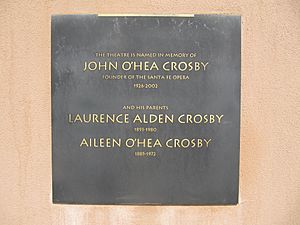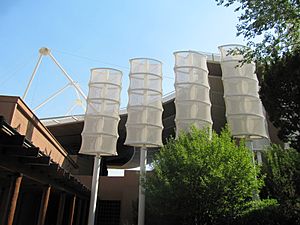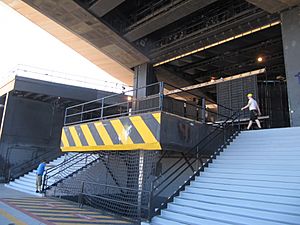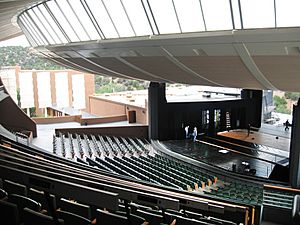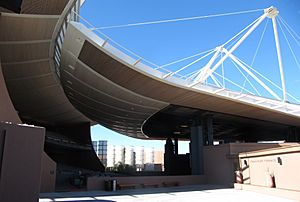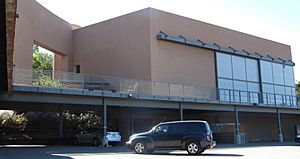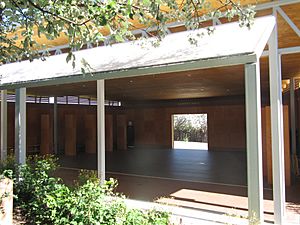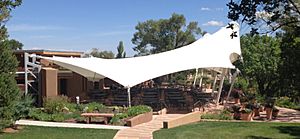Santa Fe Opera facts for kids
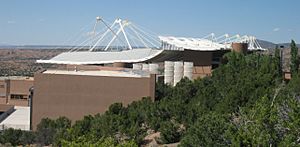
Santa Fe Opera's Crosby Theatre
|
|
| Address | 301 Opera Drive Santa Fe, New Mexico United States |
|---|---|
| Coordinates | 35°45′50″N 105°56′49″W / 35.7640°N 105.9470°W |
| Capacity | 2128 plus 106 standees |
| Current use | performing arts center |
| Construction | |
| Opened | July 3, 1957 |
| Rebuilt | 1968, 1998 |
| Architect | 1998 rebuild: James Polshek |
The Santa Fe Opera (SFO) is a famous American opera company. It is located about 7 miles (11 km) north of Santa Fe, New Mexico. The company was started in 1956 by John Crosby. He built the first opera house on a large piece of land that used to be a guest ranch.
Since July 1957, the Santa Fe Opera has put on shows every summer. It is known around the world for showing new operas. It also performs classic operas that many people love. Each summer season, five different operas are presented.
The Santa Fe Opera has hosted 45 American premieres and 18 world premieres. This means they were the first to show these operas in the U.S. or anywhere in the world. Some of these new works include Emmeline, The Tempest, and The (R)evolution of Steve Jobs.
Contents
The Story of Santa Fe Opera
John Crosby, a conductor from New York, founded the Santa Fe Opera in 1956. His parents helped him financially to buy the land and build the first opera house. Crosby wanted to give American singers a chance to learn and perform new roles. He also wanted them to have plenty of time to practice in a summer festival setting.
The very first season started on July 3, 1957. The first show was Puccini's Madama Butterfly. The theater could hold almost 500 people. John Crosby was the general director until 2000. This was the longest time anyone has held that position in U.S. opera history.
After Crosby, Richard Gaddes led the company from 2000 to 2008. Then, Charles MacKay became the general director in 2008 and served until 2018. Since October 2018, Robert K. Meya has been the general director. The company also has a music director, Harry Bicket, who helps guide the musical performances.
What You See at the Opera
The Santa Fe Opera season runs every year from late June or early July until the third week of August. They present five different operas that rotate, meaning you can see a different show almost every night.
A Mix of Old and New Operas
From the very beginning, the Santa Fe Opera has had a special way of choosing its shows. Usually, two popular operas open the season. There is often a new American opera, sometimes one that the company asked a composer to write. John Crosby loved the operas of Richard Strauss, so the company often performed his works. The fifth opera is usually a rare or less-known piece. This mix of old and new continues today.
Some modern operas that had their U.S. premiere here include The Tempest (2006) and Adriana Mater. World premieres, meaning they were first shown anywhere at Santa Fe Opera, include Cold Mountain (2015) and The (R)evolution of Steve Jobs (2017). In 2018, they premiered Doctor Atomic, which tells the story of the day before the first atomic bomb test. In 2022, they presented M. Butterfly, a new version of Madama Butterfly. They also premiered a new American opera called "The Righteous" in 2024.
Safety and Innovation During Challenging Times
In 2021, after a global health challenge, the Santa Fe Opera opened its season in July. They created a new role: Covid Compliance and Safety Manager. This person helped develop strict safety rules for everyone. They used guidelines from health organizations to keep performers and audience members safe.
To reach more people, especially younger generations, they broadcasted dress rehearsals and shows outside. People could watch from their cars like a drive-in movie theater. In 2021, they put on four productions, and by the next year, they returned to five.
Learning at the Opera
Apprentice Programs for Young Artists
John Crosby started the Apprentice Singer Program in the very first season. This program gives young singers a chance to gain experience. They get living expenses and are paid to sing in the chorus. They also learn major roles as understudies. This program was unique in America in the 1950s. It helped young singers move from school to a professional career. So far, over 1,500 aspiring opera singers have been part of this program.
Crosby explained that young artists in America often found it hard to get experience. He said their program would let young people work with experienced singers. This way, they could gain the skills they needed without having to go to Europe.
In 1965, the Apprentice Program for Technicians was added. This program teaches young people about the technical side of opera.
What Apprentices Learn
The apprentice programs have learning goals in addition to hands-on experience. Singers attend workshops and master classes. They get coaching in voice, music, movement, and how to manage their careers. Technical apprentices learn about stage operations, costumes, scenery, lighting, and makeup.
Today, about 1,000 young singers and 600 technicians apply for these programs each year. In 2014, 43 singers and almost 90 technical apprentices worked at the opera. The Santa Fe Opera is one of the few opera houses in the U.S. with a large budget that offers a technician apprentice program.
Apprentice singers perform in the chorus for each opera. They also take on small roles. Sometimes, they even step in to perform leading roles if a main singer is unable to. Technical apprentices work backstage. They handle costumes, scenery, lights, and props. They also help with the daily changes between the five different operas. There's even a program for local high school students to learn technical skills.
Famous Former Apprentices
Many famous American opera singers started as apprentices at Santa Fe Opera. These include sopranos like Susanna Phillips and Joyce El-Khoury. Mezzo-sopranos like Joyce DiDonato and Michelle DeYoung also trained here. Tenors such as William Burden and Carl Tanner were apprentices. Baritones like Sherrill Milnes and basses like Samuel Ramey also got their start at SFO.
Many of these former apprentices have returned to perform major roles with the company. For example, Joyce DiDonato performed in Cendrillon in 2006 and La donna del lago in 2013. Joyce El-Khoury returned as Micaëla in Carmen in 2014.
The Opera Houses
The Santa Fe Opera has had three different theaters on its 150-acre site. All of them have been built in the same spot on a high flat area called a mesa. The audience faces west, looking out at beautiful sunsets and sometimes thunderstorms. These views are often part of the show when there are no backdrops. In the first two theaters, bad weather sometimes caused shows to be canceled or delayed. The current theater, the Crosby Theatre, was built to improve acoustics, add more seating, and protect from the weather.
Three things make the Santa Fe Opera theaters special. First, there is no system to lower scenery from above. Second, there is no proscenium arch, which means no curtain and no way to project translations above the stage. Third, the sides of the theater are open, and the back of the stage can be fully opened. This allows for amazing views of the landscape.
Performances start close to sunset. This way, the stage lighting works well even with the open sides. Since 2011, shows have started at 8:30 PM. This timing also lets opera-goers enjoy the New Mexico sunsets and have traditional "tailgate" dinners before the show.
The First Theater (1957-1967)

The first open-air theater was designed to hold 480 people and cost $115,000 to build. John Crosby and an expert chose the perfect spot for its natural sound. It was the only outdoor theater in America made just for opera. The audience sat on benches.
The first show, Madama Butterfly, on July 3, 1957, was sold out. By the end of that first season, 12,000 people had attended, filling 90% of the seats.
In 1965, a mezzanine (a partial floor) was added. But on July 27, 1967, a fire destroyed the theater. The company had to move to a local high school gym for the rest of the season. They called it the "Sweeney Opera House." A huge effort to raise money began, supported by famous composer Igor Stravinsky. They raised $2.4 million to rebuild the theater in time for the next season.
The Rebuilt Theater (1968-1997)
The second theater, also open-air, was ready by June 26, 1968. It could seat 1,889 people. Just like the first opening night, it featured Puccini’s Madama Butterfly.
This new theater had a roof that partially opened in the middle. The sides of the auditorium were open, and the back of the stage could also be opened. This offered amazing views to the west and allowed some audience members to see the night sky.
Most of the backstage areas, like scenery construction and costume shops, were built below the stage. This kept the beautiful views clear. A large elevator, called the "B-Lift," was installed behind the stage. It moves scenery up from the shop or down to storage areas. This elevator is still used today.
The Crosby Theatre (Since 1998)
The current theater is named the Crosby Theatre. It honors John Crosby and his parents for their contributions. It was designed by architect James Polshek.
The old auditorium was torn down in August 1997. The stage and backstage areas remained. The new theater was built in just ten months and opened in early July 1998. Again, Madama Butterfly was the opening night performance.
The Crosby Theatre has a wider and more complete roof. This roof protects from the sky, but the sides are still open. It seats 2,128 people, plus 106 standing spots, yet it feels very close and personal. Wind baffles and a nearby rehearsal hall help protect from the wind. On August 9, 2019, a performance of The 13th Child was paused for 20 minutes due to bad weather. This was a rare event for the Crosby Theatre.
In 1999, an electronic titles system was installed. Instead of large projected translations, small screens are in front of each seat. They show a two-line translation of the opera in English or Spanish. This system can even handle up to six languages.
Besides operas, the Crosby Theatre has also hosted concerts by popular music groups like The B-52s and Wilco.
Stieren Orchestra Hall
The Stieren Orchestra Hall was completed in 2001. It provides a much-needed rehearsal space for the orchestra. The building has three levels and covers 12,650 square feet (1,175 square meters). It is also used for lectures, recitals, and social events.
The main level has guide rails on the ceiling that show the exact size of the opera stage. This allows for full rehearsals with scenery. Large sliding doors connect it to the scenery deck. The upper level has studios for singers to get one-on-one coaching. The lower level has a large, air-conditioned costume storage area. The roof of Stieren Orchestra Hall has 135 solar panels, as the SFO is moving towards using solar power.
Rehearsal Halls
There are eight rehearsal halls on the opera campus. They range in size from full-scale replicas of the Crosby Theatre stage to small studios for individual coaching. The newest full-size hall, the Richard Gaddes Rehearsal Hall, was completed in 2010. Another large hall, O'Shaughnessy Hall, was updated in 2012. These halls allow several operas to be rehearsed at the same time.
Dapples Pavilion (The Cantina)
The original "cantina" (a dining area) was torn down after the 2007 season. A new one was built and opened in 2008. It has modern kitchens and serving areas. Its arched roof matches the design of the Crosby Theatre.
Now called the Dapples Pavilion, it is named after a long-time supporter, Florence Dapples. The cantina provides food and drinks for the staff and artists throughout the season. In the evenings, it hosts "Preview Buffet" dinners for the public. These dinners include a talk about the opera before the show.
Images for kids
-
Bust of Stravinsky on the Stravinsky Terrace
See also
 In Spanish: Ópera de Santa Fe para niños
In Spanish: Ópera de Santa Fe para niños


